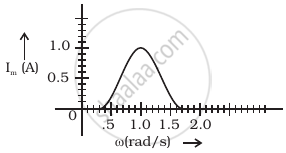Advertisements
Advertisements
Question
Why does current in a steady state not flow in a capacitor connected across a battery? However momentary current does flow during charging or discharging of the capacitor. Explain.
Solution
In steady state condition, voltage across the capacitor nearly equals to the voltage of the charging source. Hence net voltage acting in the circuit is zero. Due to this there is no flow of charge (current) through the circuit and hence the capacitor.
Now we know for an uncharged capacitor the potential difference across the capacitor is zero. So when it is connected to a battery, the battery begins to charge it by withdrawing the free electrons from one plate connected with the positive terminal of the battery of the capacitance and deposit on the other plate of the capacitor. So, due to this flow of charge, there exist a momentary current while charging of the capacitor. Now when the capacitor is fully charged i.e. voltage across the capacitor nearly equals to the voltage of the charging source, the current in the circuit vanishes.
Now in case of discharging of a charged capacitor, the battery gets replaced by a wire of say resistance R. Hence the capacitor itself acts as a battery now and flow of charge exists in the circuit from negative plate to the positive plate of the battery. This leads to momentary current in the circuit. As soon as the all the positive charges on one plate gets neutralised by the negative charges on the other plate, the flow of charge stops and hence the current.
APPEARS IN
RELATED QUESTIONS
The time constant of an LR circuit is 40 ms. The circuit is connected at t = 0 and the steady-state current is found to be 2.0 A. Find the current at (a) t = 10 ms (b) t = 20 ms, (c) t = 100 ms and (d) t = 1 s.
The current in a discharging LR circuit without the battery drops from 2.0 A to 1.0 A in 0.10 s. (a) Find the time constant of the circuit. (b) If the inductance of the circuit 4.0 H, what is its resistance?
In a series LCR circuit supplied with AC, ______.
If an LCR series circuit is connected to an ac source, then at resonance the voltage across ______.
In a series LCR circuit the voltage across an inductor, capacitor and resistor are 20 V, 20 V and 40 V respectively. The phase difference between the applied voltage and the current in the circuit is ______.
To reduce the resonant frequency in an LCR series circuit with a generator
A series LCR circuit containing 5.0 H inductor, 80 µF capacitor and 40 Ω resistor is connected to 230 V variable frequency ac source. The angular frequencies of the source at which power transferred to the circuit is half the power at the resonant angular frequency are likely to be ______.
In series LCR circuit, the plot of Imax vs ω is shown in figure. Find the bandwidth and mark in the figure.

Draw the phasor diagram for a series LRC circuit connected to an AC source.
Draw a labelled graph showing variation of impedance (Z) of a series LCR circuit Vs frequency (f) of the ac supply. Mark the resonant frequency as f0·
